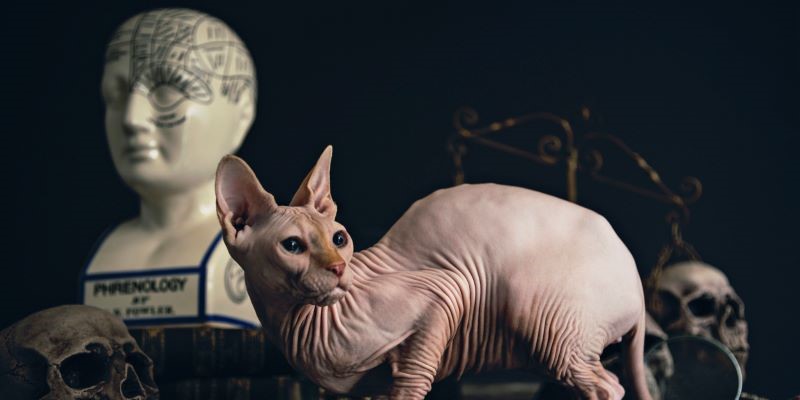| By K. Lee Lerner|
Made popular by a million memes, the famous Schrödinger’s cat thought experiment (also called the Schrödinger’s cat paradox), devised by physicist Erwin Schrödinger (1887–1961). In 1935, was designed to illustrate the often bizarre implications of quantum mechanics (specifically, superposition and the concept of quantum measurement).
Analogous to a radioactive atom that, in the quantum world, is simultaneously decayed and not decayed, Schrödinger’s cat in an unopened box is simultaneously alive and dead (a state of superposition) until the box is opened. When observed (i.e., measured), the quantum superposition collapses into a definite state and we behold either a living or dead cat.
According to the Copenhagen interpretation of quantum mechanics, the act of measurement collapses the wave function that represents all possible states and outcomes for a system. In our everyday experience, cats can’t be simultaneously in two states (i.e., alive and dead), nor would non-interfering observation force the cat into one state (alive or dead). But quantum physics is fundamentally counterintuitive. Moreover, nature is not obliged to act in accord with what’s convenient or easy to understand, which is why, beyond mathematics, quantum thought problems are often our best way to conceptualize and convey quantum mechanics.
The Schrödinger’s cat thought experiment involves more than simply a cat in a box. In Schrödinger’s system, along with the cat there’s a single radioactive atom in the box and an intermediate mechanism (e.g., a Geiger counter, a hammer, and a vial of poison).
In the quantum world, the radioactive atom is in superposition (both decayed and not decayed). Because the atom is in superposition, the cat is equally in superposition (both alive and dead). When the atom decays, it triggers the Geiger counter which triggers the hammer to break the vial of poison which kills the cat. In this entangled system, the state of the cat is determined by the state of the atom. By observing the cat, one can also infer the state of the atom (decayed or not decayed).
In the quantum world, particles like photons also exhibit superposition (i.e., exist in multiple states or locations simultaneously), showing a wave-particle duality until measured or observed.
Despite being counterintuitive, quantum superposition can be demonstrated based on the foundational ideas of interference in the wave behavior of light, as shown in a double slit experiment in 1801 by Thomas Young (1773–1829). Young’s study was expanded upon by Albert Einstein (1879–1955), whose photoelectric effect theory in 1905 proposed that light behaves as both waves and particles (photons) in the modern physics version of the double slit experiment. A beam of particles (typically electrons or photons) is directed toward a barrier with two narrow slits. Behind the barrier, there’s a screen that detects where the particles impact after passing through the slits.
In classical physics, one would expect to see two distinct bands of particles on the screen corresponding to particles passing through one of the two slits, with particles having an equal probability of going through either slit. When individual particles are sent toward the slits, however, instead of hitting inside one of the two target area bands on the screen beyond the slits, an interference pattern of alternating bands of high and low intensity emerges (i.e., bright and dark fringes), indicating individual particles (photons) act like a wave passing simultaneously through both slits.
Before measurement, each particle is in superposition, passing through both slits as though it’s a wave. The act of measurement or observation collapses the superposition state (or wave) into the definite position and the outcomes typically expected with particle-like behavior.
The phenomenon described by Schrödinger’s cat has importance in the emerging field of quantum computing and other superconductive electronics. In classical computing, a bit is represented by a 1 or 0 (i.e., a switch that’s on or off). In quantum computing, however, the fundamental qubits (quantum bits) can exist in superpositions of 1 and 0. For more information on this interesting subject, please see the Gale In Context: Science database.
 About the Author
About the Author
Recognized for his use of language, accuracy, and balanced presentation, K. Lee Lerner’s portfolio covering science and global issues for Cengage includes two ALA RUSA Book and Media Awards and two works named Outstanding Academic Titles. Holding degrees in science, education, and journalism, including a master’s degree with academic honors from Harvard, Lerner has served on the board of advisors for the venerable American Men and Women of Science since 2003 and, along with Brenda Wilmoth Lerner, as coeditor for three editions of the Gale Encyclopedia of Science. He was the contributing editor-in-chief for Gale’s Encyclopedia of Espionage, Intelligence, and Security. A member of the National Press Club in Washington, DC, Lerner is an experienced aviator and sailor who has completed two global circumnavigations. His Academia site consistently ranks among those most frequently accessed by students, scholars, and decision-makers from around the world. Additional information may be found at https://scholar.harvard.edu/kleelerner and https://harvard.academia.edu/KLeeLerner/


